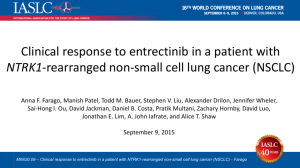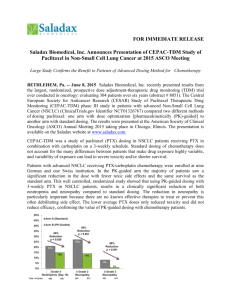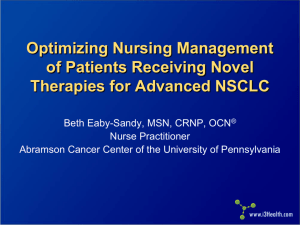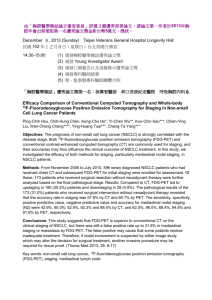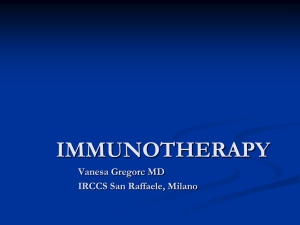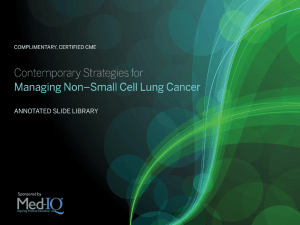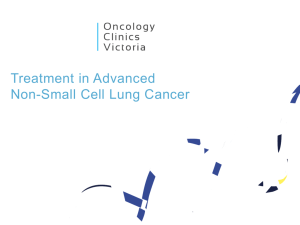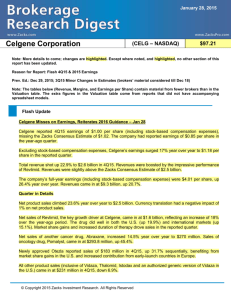Nab-paclitaxel submission - McKesson Specialty Health
advertisement
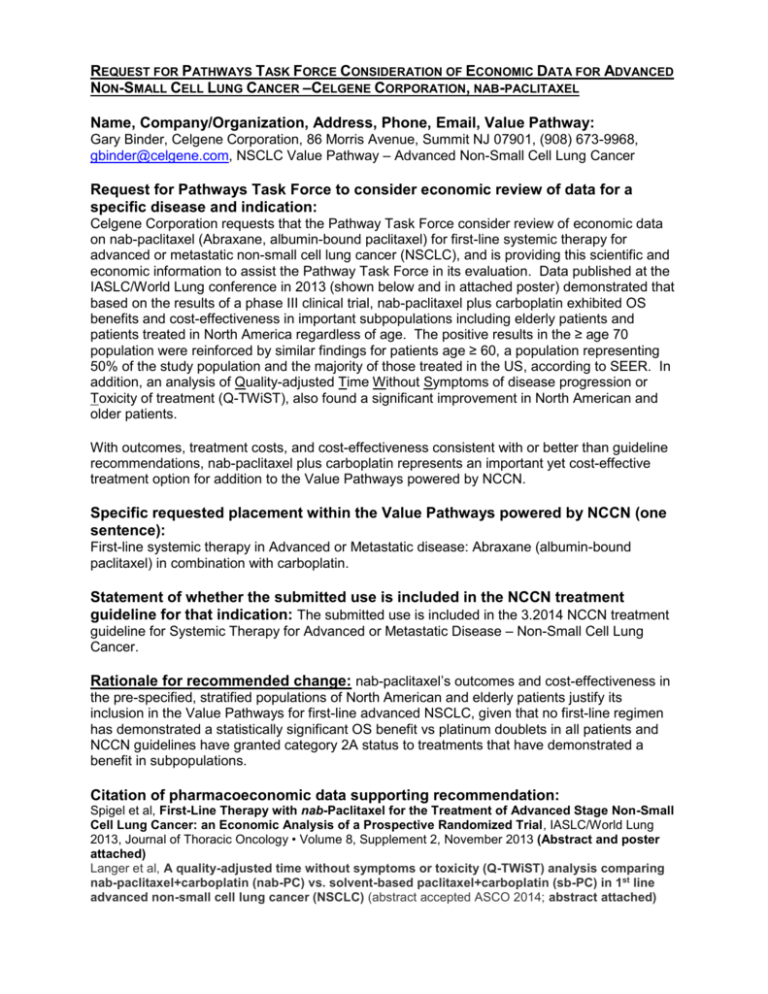
REQUEST FOR PATHWAYS TASK FORCE CONSIDERATION OF ECONOMIC DATA FOR ADVANCED NON-SMALL CELL LUNG CANCER –CELGENE CORPORATION, NAB-PACLITAXEL Name, Company/Organization, Address, Phone, Email, Value Pathway: Gary Binder, Celgene Corporation, 86 Morris Avenue, Summit NJ 07901, (908) 673-9968, gbinder@celgene.com, NSCLC Value Pathway – Advanced Non-Small Cell Lung Cancer Request for Pathways Task Force to consider economic review of data for a specific disease and indication: Celgene Corporation requests that the Pathway Task Force consider review of economic data on nab-paclitaxel (Abraxane, albumin-bound paclitaxel) for first-line systemic therapy for advanced or metastatic non-small cell lung cancer (NSCLC), and is providing this scientific and economic information to assist the Pathway Task Force in its evaluation. Data published at the IASLC/World Lung conference in 2013 (shown below and in attached poster) demonstrated that based on the results of a phase III clinical trial, nab-paclitaxel plus carboplatin exhibited OS benefits and cost-effectiveness in important subpopulations including elderly patients and patients treated in North America regardless of age. The positive results in the ≥ age 70 population were reinforced by similar findings for patients age ≥ 60, a population representing 50% of the study population and the majority of those treated in the US, according to SEER. In addition, an analysis of Quality-adjusted Time Without Symptoms of disease progression or Toxicity of treatment (Q-TWiST), also found a significant improvement in North American and older patients. With outcomes, treatment costs, and cost-effectiveness consistent with or better than guideline recommendations, nab-paclitaxel plus carboplatin represents an important yet cost-effective treatment option for addition to the Value Pathways powered by NCCN. Specific requested placement within the Value Pathways powered by NCCN (one sentence): First-line systemic therapy in Advanced or Metastatic disease: Abraxane (albumin-bound paclitaxel) in combination with carboplatin. Statement of whether the submitted use is included in the NCCN treatment guideline for that indication: The submitted use is included in the 3.2014 NCCN treatment guideline for Systemic Therapy for Advanced or Metastatic Disease – Non-Small Cell Lung Cancer. Rationale for recommended change: nab-paclitaxel’s outcomes and cost-effectiveness in the pre-specified, stratified populations of North American and elderly patients justify its inclusion in the Value Pathways for first-line advanced NSCLC, given that no first-line regimen has demonstrated a statistically significant OS benefit vs platinum doublets in all patients and NCCN guidelines have granted category 2A status to treatments that have demonstrated a benefit in subpopulations. Citation of pharmacoeconomic data supporting recommendation: Spigel et al, First-Line Therapy with nab-Paclitaxel for the Treatment of Advanced Stage Non-Small Cell Lung Cancer: an Economic Analysis of a Prospective Randomized Trial, IASLC/World Lung 2013, Journal of Thoracic Oncology • Volume 8, Supplement 2, November 2013 (Abstract and poster attached) Langer et al, A quality-adjusted time without symptoms or toxicity (Q-TWiST) analysis comparing nab-paclitaxel+carboplatin (nab-PC) vs. solvent-based paclitaxel+carboplatin (sb-PC) in 1st line advanced non-small cell lung cancer (NSCLC) (abstract accepted ASCO 2014; abstract attached) APPENDIX: Journal of Thoracic Oncology • Volume 8, Supplement 2, November 2013 P3.10-043 NAB-PACLITAXEL IN COMBINATION WITH CARBOPLATIN AS FIRST-LINE THERAPY IN PATIENTS (PTS) WITH ADVANCED NON-SMALL CELL LUNG CANCER (NSCLC): AN ECONOMIC ANALYSIS David Spigel1, William Harwin2, George Dranitsaris3, Gary Binder4,Paul Weber4, Markus F. Renschler4, Mark A. Socinski5 1 Sarah Cannon Research Institute, 2 Sarah Cannon Research Institute, Florida Cancer Specialists, 3 Augmentium Pharma Consulting/Canada, 4 Celgene Corporation, 5 Hematology/Oncology, University Of Pittsburgh Background: In a phase III trial in first-line, advanced NSCLC, nab-paclitaxel + carboplatin (nab-P/C) significantly increased tumor response rates, with comparable overall survival (OS) vs solvent-based paclitaxel + carboplatin (sb-P/C). However, nab-P/C improved OS in prespecified, stratified subgroups of pts, including those aged ≥ 70 y (19.9 vs 10.4 mo; P = 0.009) and in North American pts, (12.7 vs 9.8 mo; P = 0.008). Based on the data from this trial, nab-P/C was approved by the US Food and Drug Administration (FDA) as a first-line treatment in advanced NSCLC, a condition for which no drug has demonstrated a clinically meaningful survival advantage vs platinum doublets in an unselected population in FDA registration trials. Here, we report results of a cost-effectiveness analysis that was conducted from the US payer perspective, with resource use data collected during the trial. Methods: Cost-of-care estimates were applied to patient-level data on chemotherapy, drug delivery, patient monitoring, supportive care drugs, and treatment of dose-limiting toxicity. Cost-effectiveness outcomes were presented as incremental cost per life year ($/LY) gained with nab-P. Results: Use of colony stimulating factors and treatment discontinuations due to toxicity were comparable between experimental and control arms. Taxane dose intensity was higher with nab-P vs sb-P (79.6% vs 61.8%). For all pts, the nab-P/C group had a $25,868 higher cost compared with sb-P/C ($35,179 vs $9,310) and an incremental $/LY gained in excess of $100K, comparable with $/LY gained estimates published for other recently approved NSCLC agents. However, in the subsets of pts aged ≥ 70 y and those from North America, the cost differential was reduced to $18,244 and $19,941, respectively. $/LY gained was reduced to $23,000 and $83,000, respectively, which compares favorably with published incremental $/LY gained for other NSCLC agents based on their OS advantage in patient subpopulations. Similar results were observed in a post hoc analysis of the subgroup of pts aged ≥ 60 y. Conclusion: Weekly nab-P/C can be considered a clinically and economically attractive treatment option for US payers for first-line advanced NSCLC, particularly in the North American and elderly subsets. Future clinical trials are needed to validate these findings. Additional data supporting recommendation: In order to weigh the tradeoffs between OS and adverse events (AEs) a Quality-adjusted Time Without Symptoms of disease progression or Toxicity of treatment (Q-TWiST) may be utilized. By partitioning survival time into a series of health states and weighting these states with different utilities, the Q-TWiST method combines quantity and quality of life into a single measure. Since its first application in breast cancer, the Q-TWiST method has been widely applied to other cancers and disease conditions over the past decade. An abstract describing the benefits of Abraxane has been accepted for the upcoming 2014 ASCO conference (see attached materials). A quality-adjusted time without symptoms or toxicity (Q-TWiST) analysis comparing nabpaclitaxel+carboplatin (nab-PC) vs. solvent-based paclitaxel+carboplatin (sb-PC) in 1st line advanced non-small cell lung cancer (NSCLC) [ASCO submission 2014] Authors: Corey Langer1, Vera Hirsch2, Yin Wan3, Fang-Ju Lin3, Scott Whiting4, TJ Ong4, Marc Botteman3 Affiliations: 1University of Pennsylvania Hospital, Philadelphia, Pennsylvania, 2 McGill University Health Centre, Montreal, Canada, 3Pharmerit North America, Bethesda, Maryland; 4Celgene Corporation, Summit, New Jersey Background: To compare the quality-adjusted survival of nab-PC vs. sb-PC in 1st line advanced NSCLC, the Q-TWiST methodology was applied to a Phase-3 randomized clinical trial which showed noninferiority for nab-PC (Socinski et al, 2012). Methods: Overall survival (OS) was partitioned into time: before disease progression without grade ≥3 toxicity (TWiST); with grade ≥3 toxicity (TOX); and after disease progression (REL). Mean Q-TWiST was calculated by multiplying the time spent in each health state by utilities to estimate the quality-adjusted OS. In the base case, the health state utilities were assigned TWiST=1; TOX=0.5; REL=0.5. In threshold analyses, TOX and REL utilities were varied from 0 to 1. Comparisons between treatments were made for the intent-to-treat (ITT) population and subgroups by age, region, histology, and stage. Nonparametric bootstrap 95-percentile confidence intervals (95% CI) were derived to assess the statistical significance of differences in Q-TWiST. A relative gain in Q-TWiST (vs. mean overall survival of control group) of ≥10% was defined as clinically important (Revicki et al, 2006). Results: The ITT population included 1,052 patients. In the base case, nab-PC patients (vs. sb-PC) gained a non-significant 0.45 month of Q-TWiST (10.4 (n=521) vs. 10.0 (n=531) months; 95% CI: -0.4, 1.4). In North American patients, nab-PC yielded a statistically significant Q-TWiST gain of 2.5 months (10.2 (n=81) vs. 7.6 (n=84) months; 95% CI: 0.6, 4.3), with a relative Q-TWiST gain of 23.3% (range in threshold analysis 18.4-28.4%). nab-PC patients aged ≥60 years also had statistically significant QTWiST gains of 1.4 months (11.1 (n=265) vs. 9.8 (n=281) months; 95% CI: 0.2, 2.6), with a relative gain of 10.8% (range in threshold analysis 6.4-15.1%). In nearly all other subgroups, Q-TWiST differences also favored nab-PC but were not significant. Conclusions: Relative to sb-PC, nab-PC provides a clinically important and statistically significant improvement in quality-adjusted survival in advanced NSCLC patients ≥60 years or from North America.

